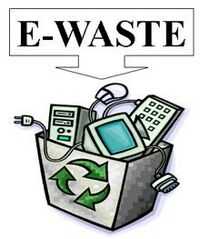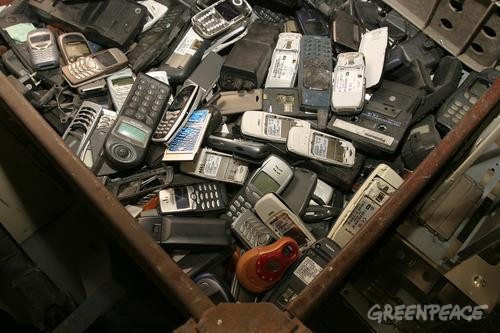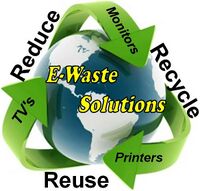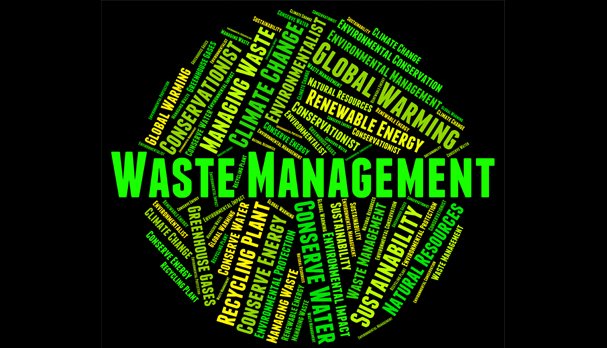E-Waste
E-waste, or electronic waste, is most easily defined as any discarded electronic equipment, such as computers, televisions, stereo systems, electrical components, and mobile phones. Most of these electronic devices have outlived their usable life cycle and can no longer be used for their original intended purpose. However, they can be reused or recycled into a new product for future use. Computers are often thought of as the main contributors to e-waste, but they are only a portion of all of the e-waste that is being generated. Other forms of e-waste include refrigerators, freezers, washers, dryers, and other large household appliances. Once these equipment types have been used to the fullest or have expired, the consumers dispose of the equipment without thinking about what will happen to them.
Causes and Effects
Electronic waste, more commonly known as e-waste, can be classified as the disposal of electrical and electronic equipment. Often time when these products are discarded, there is a lack of consensus as to what should be done with them. There are many options on what to do with the products depending on the nature of the product, such as resale, refurbish, and reuse. Today a lot of electronics are being used in a manner that is detrimental to society in many ways. The major issue of e-waste is at an all-time high because many companies continue to update new versions of products, without necessarily making them better than the previous versions. “The increasing availability of new electronics, along with the higher number of products built with shorter life spans, has resulted in the current explosion of e-waste”.[1] Usually the consumer falls directly into the trap of the companies, everyone always feels as if they must have the latest of what’s on the market, but don’t really think twice about where their old products are going. Many of our consumers are contributing directly to the e-waste epidemic without even realizing. Every day in the United States, people throw away or recycle their electronic products, but they aren’t necessarily aware of how harmful it can be to the environment we live in. “E-waste contains approximately 1,000 chemicals, including mercury, lead oxide, cadmium, and polyvinyl chloride, which are especially hazardous to human health”. In order to resell electronics, salvage companies have to remove, lead, copper, gold and a number of other valuable metals from them, but by doing this, harmful chemicals are also being released into the air and the water streams. Individuals who are exposed, are then in potential danger of certain health issues such as lung cancer, lung disease, and brain & kidney damage. E-waste not only creates health issues, but it also causes environmental problems as well. Usually when we think of environmental issues, we tend to think that it doesn’t directly affect us—it definitely does in a number of ways. When toxic chemicals are released during the e-waste process, it causes air pollution and water pollution which are extremely essential for human survival. So in a way, health and environmental consequences are intertwined when destroying products in this manner. The idea of attempting to make an additional profit from destroying old products to make new ones is actually intelligent; however, the way that it is currently being executed is inefficient. The issue of e-waste could be simply avoided by using safer recycling methods, but like almost everything in this world, it costs money to do so. Developed countries should be to blame for the outcomes of e-waste in my opinion. A lot of established countries, such as the United States send electronics that have been disposed of, to more underdeveloped societies to be recycled. In many foreign countries, labor is cheap and regulations aren’t very strict, meaning that they can dispose of equipment in almost any way they choose without paying much, and still make a profit.
Another effect of e-waste is that the process keeps the underdeveloped country in their current living situations. Many affluent countries usually send their electronic goods to other countries to fulfill the actual process of re-establishing these products because of the cheap pricing. However, the lack of payment, as well as the many health factors that come with dismantling these electronics, is not allowing certain places in the world to uprise and become a strong nation like their counterparts. The issue of e-waste has both positive and negative aspects to it. Although the United States makes a profit from e-waste, it definitely poses many harmful effects on the individuals who actually destroy these electronics for a living and our environment. The impacts of e-waste don't make the profit worth it. If we allow these types of things to occur in our society, is money more important than the welfare of what lies within our environment? That is one question that should be answered with the issue of e-waste.
Solutions
As this issue and threat of E-Waste is being identified, now it is important for us to look for possible solutions and alternatives to deal with it. It is believed that many people are unaware regarding what happens when they dispose their electric equipment. The first thing that can be done easily is by educating people about E-waste. Education can be started from primary level, which includes special classes regarding e-waste in schools and colleges. As well as government can also educate people through awareness campaigns/programs using advertisement on newspapers, radios, TV and bill boards. When people will have the knowledge about the effects of E-waste, they will think twice before buying a new electronic product. It will also encourage them to buy more green products, which are more environmental friendly. However, one may think is it government’s duty to spend money on these campaigns/program. The answer to this question can be that government collects taxes from public and spend back on them for public welfare. So, it is their responsibility to protect the environment from pollution and provide healthy living conditions for the tax payers. This method will be cost effective as well as the results can be achieved in quickly. Apart from this, government can fund educational and research institutes to find effective possible solutions which will reduce environmental pollution caused by E-waste. Moreover, instead of disposing electric equipment, individuals can donate their computers, cell phones and TVs to charity organization, educational institutes, non-profit organizations or technology training foundations. This will not only increase the life and usage of the equipment, but also will result in lesser demand of the equipment. Once the product is being used to the fullest, it can be returned to the manufacturer, who can refurbish it and sell back at cheaper price. Refurbishing itself is one sub-kind of recycling. If refurbishing is done in proper way, the amount of E-waste dispose can be reduced by large number.
Another step that the manufacturers can take is by making more environment friendly products (green products). Even if these products are more costly and expensive, we as a society have to decide which cost is more beneficial for us to pay: high product price or a polluted environment. Green products have a longer estimated life and cause very less pollution compared to common goods that we use in our daily life. Furthermore, it is more convenient to recycle them. Manufacturers can also play their part by using less lead and other toxic substances in their product and by using less harmful substances as an alternative.
In connection to recycling of E-waste, responsible authorities all over the world need to take some firm decisions. First of all, the labor which is involved in this process should be professionally trained and certified. Many under-develop countries which dispose E-waste are using child labor, which should be discouraged. Additionally, the place where recycling will take place should be inspected and approved by the government authority. Importantly, the factories or disposal plants should be located far away from city (living area) and the waste shouldn’t be thrown in rivers or canals which provide water for drinking and irrigational purposes. They should have proper equipment as well as an appropriate working environment. To prevent health hazards, workers should be paid for health insurance. Additionally, instead of using only man power, companies can use computers and robots for recycling. Among all these, we as a society have to take responsibility collectively to deal with this problem. Manufacturers should not only think regarding high profit margins and using harmful substances in their product. They should realize that if the effects of their products are dangerous to people, they are included in them also. At same, the consumers should also think when disposing old products or buying new products that do they really need to buy/dispose this. Is it essential for them to buy a new updated product or is the old product not working to its potential and fulfilling their needs? And at last, responsible authorities (government) should have a proper system of checks and balances. They should fine the manufacturers who are not disposing of the E-waste properly (recycling and disposing).
Government efforts and laws regarding E-waste
United States
As electronic waste was a recent and still is an upcoming problem, the first laws that regulated it were put into action in the year 2003. California was the first state to have e-waste laws, and it is one of the few states that actually have such laws. Out of the 50 states, only 25 enforce e-waste laws. Each of these states have their own set of rules and regulations concerning e-waste; some states handle the problem differently from others. For example, California have people pay a fee for recycling e-waste while New York provides free recycling services. Although each state has their own specific set of rules, there are general ideals that are shared between the laws. It is agreed that e-waste should be properly taken care of by the manufacturers who produce it and nearly all of the states that enforce e-waste laws leave the responsibility of recycling to the manufacturers. Most of the states have manufacturers register at the local Department of Environmental Protection annually, allowing the states to keep tabs on manufacturers that produce electronic devices. Some states, such as Illinois and Indiana, require manufacturers to recycle a certain amount of closed electronic devices a year. Manufacturers are fined a fee if they fail to recycle enough e-waste to meet the quota. Some states also have the manufacturers provide recycling services for consumers. There are other states that have no proper e-waste laws, but have disposal bans on electronic devices. Citizens are fined for disposing electronic devices as regular garbage. Instead, they must properly dispose of their e-waste at recycling companies. States that have such disposal bans include Arkansas, Massachusetts, and New Hampshire. Because e-waste has only started becoming a problem within the past decade, the United States are still trying to find a way to properly and efficiently deal with it.
International
The United States is not the only one who is actively trying to push for proper e-waste disposal. Europe also has their own systems of disposing e-waste. The Waste Electrical and Electronic Equipment Directive (WEEE Directive) is the European's attempt at cleaning e-waste disposal. The WEEE Directive sets collection targets for the country, similar to the United States, and from there the country works to properly dispose the collected e-waste. In the last year, the WEEE Directive had set a goal of collecting 2 tons of e-waste and successfully met the quota. This year, the organization will be pushing to collect even more e-waste than last year and are also working on preventing illegal exports of e-waste to other countries.[2] Australia is another continent that has recently adopted a few of their own e-waste laws. Australia, like Europe and the United States, is pushing for recycling used and old electronic devices. Similar to the policies of the United States, Australia is putting the responsibility of recycling on the manufacturers. They have a clause called the “Extended Producer Responsibility,” shortened as EPR, which requires all manufacturers and importers of televisions and computers to collect and recycle these products. Australia's government is currently developing more regulations concerning e-waste through with their Environment Protection and Heritage Council. Australia also banned landfills of e-waste, promoting the recycling of e-waste.[3] Although there are some countries that are working for a cleaner disposal of e-waste, there are many countries that simply do not care for the matter. China is perhaps the greatest example of this. Almost 70% of the entire world's e-waste is dumped onto China.[4] Once the e-waste reaches china, poverty stricken civilians heat and melt e-waste, extracting valuable parts while trashing garbage parts. This is the worst and unfortunately, the most popular way, to deal with e-waste. Not only does it harm the people who are disposing the waste first hand, but pollution is also spreading worldwide from disposing e-waste in this fashion. Rivers that were once flowing with life become barren with pollution. Children who live around the area are impacted harshly, suffering from the pollution first-hand. In countries like China, India and Ghana, little is done to fix the e-waste problem .[5] With such an easy method to earn money, there is no desire for these countries to spend more money to properly dispose e-waste. As of now, e-waste is a problem only certain groups of people can tackle. Normal civilians have no way of properly disposing e-waste by themselves; they must rely on certified recyclers and organizations. The best an average civilian can do is to collect their old electronic devices and hand them over to the manufacturers that produced them. However, the world's major powers should push for a cleaner disposal of e-waste around the world. The countries that are already working towards the goal, such as the United States, should encourage other unmotivated countries such as China and India. As the situation stands, a majority of the world is ignoring the problem that e-waste poses and the only way to prevent further damage is for the world to join forces and formulate a solution together.
Challenges with E-commerce
As E-commerce grows up, many issues have emerged into our society. These issues are different type of issue that we were not used to see it. Economictimes stated many problems through the E-commerce that related to the E-commerce[6]
Different Regulations
Different nations has different regulations, however E-commerce doesn't have any board within the internet server. Many companies are competing through the E-Business but since they are from different nations, they are under different regulations and different situation. This might not seem a big problem, however let's think about Youtube and Youku Tudou. Youtube and Youku Tudou can compete under same situation when they are in the U.S. Is it same in the China? No China is a communism country and they put different server speed for different company and for youtube they made in unavailable. Isn't it weird? [7]
Data Management
Since the E-business requires to use many other different systems, even though company saves many costs they are wasting a lot of money to build on several data management system while they are hiring less people. This problem can connect to the unemployment problem as well. '
Technology
Fast growing technology gave consumers the power to compare and select companies among many E-commerce based companies. And finally this problem made huge competition in the market. This brought up many technical issues of running an online store such as server issues, bandwidth issues, dynamic IP address, data privacy and security issues.
Illegal
E-commerce has become a big problem for drugs and other substances, both legal and illegal. The option to purchase things like alcohol and cigarette through the internet has made ease of purchase from underaged youth more possible. Frequent news of such occurances happen, with the purchase as easy as going on the site, purchasing the product, and having it delivered to your doorsteps. [8]
Challenges with Online Marketing
Not only with drugs and other substances like cigarettes or alcohol, pharmaceutical drugs have become a topic of discussion in their delivery of marketing to the audience. Direct to consumer marketing, through online platforms, this topic has been very controversial to the industry and many arguments for both sides defend their position. [9]
With an ease of communication for suppliers to consumers through "New Media" technology, the problem of it being too easy to access becomes an issue and the intent of the marketing, whether to profit or to actually treat illnesses. In the case of Juul, their online marketing was targeted by the FDA for being too friendly and attractive to the younger crowd on social media.
How we are to address such issues of online marketing for substances that can be harmful is a new problem to new media. Whether through regulation or through corporate social responsibility, it is up for debate.
References
- ↑ Terada, C. (2012). Recycling Electronic Wastes in Nigeria: Putting Environmental and Human Rights at Risk. Journal of International Human Rights, 10(4), 154-172.
- ↑ http://ec.europa.eu/environment/waste/weee/index_en.htm
- ↑ http://www.epa.sa.gov.au/environmental_info/waste/e-waste
- ↑ http://www.china.org.cn/environment/2012-05/24/content_25461996.htm
- ↑ Verne Kopytoff, “ The complex Business of Recycling E-waste” January 08 2013. http://www.businessweek.com/articles/2013-01-08/the-complex-business-of-recycling-e-waste
- ↑ https://economictimes.indiatimes.com/small-biz/marketing-branding/marketing/six-key-challenges-facing-modern-e-commerce/articleshow/61503054.cms
- ↑ https://www.youtube.com/watch?v=SA6x96-iHpw&vl=en
- ↑ https://abcnews.go.com/GMA/story?id=127203&page=1
- ↑ https://www.ncbi.nlm.nih.gov/pmc/articles/PMC3278148/




